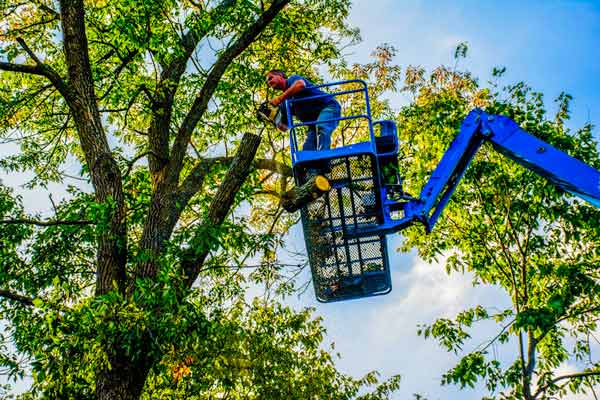Some properties have beautiful views. If you have bought land with a nice view, it makes sense to build your house in a way that takes advantage of that view. For example, you might put your deck outside of the main living area in the house and position the house so that this main area faces the view.
One day, when admiring the view, you notice some trees starting to grow on your neighbours’ property. You hope the trees won’t grow too high, but they do. They grow right in front of your view and block huge part of it. You often reminisce about what the view used to look like, and you start to resent your neighbours (whether or not they intended to block your glorious view).
It can be distressing when that view becomes blocked by your neighbours’ trees. You may wonder what you can do about it, given that the trees do not belong to you. Rest assured that the law can provide some relief.
The law on removing trees blocking your view
The Property Law Act provides a remedy for people adversely affected by trees on neighbouring properties to obtain a Court order for their removal. The Court has discretion as to whether it will make the order, but can require the owner of land upon which trees are located to trim or remove the trees if they unduly obstruct the views enjoyed by a neighbouring property.
The Court’s discretion is not as wide as it may appear; there are some restrictions on the Court’s power. The Court’s discretion to make an order for removal of trees is to be exercised cautiously. The Court may only make an order if it is permitted to do so after having regard to all the relevant circumstances. The Court must consider whether the order to remove trees is fair, reasonable and necessary to prevent an undue obstruction of the view that would otherwise be enjoyed from your land, and whether a refusal to make the order would cause hardship to you, that is greater than the hardship that would be caused to your neighbours.
The restrictions on the exercise of the Court’s discretion do not end there. In determining whether to make an order, the Court must also take into account:
- Whether the trees complained of were already there when you purchased the land;
- The interests of the public in the maintenance of an aesthetically pleasing environment;
- The desirability of protecting public reserves containing trees;
- The value of the tree as a public amenity;
- Any historical, cultural, or scientific significant of the tree.
After considering all these things, an order may be made if, in all the circumstances, “the Court thinks fit”.
Examples of an order for the removal of trees
There have been many cases decided in favour of the applicant where they claim a loss of view resulting from trees planted on neighbouring properties.
Thomas v Broome (2009)
In a case between Mr Thomas and Ms Broome, trees totalling 280 on Mr Thomas’ property had to be completely removed because 69 of the trees unduly obstructed Ms Broome’s view of the Akaroa Harbour, significantly reducing the value of the property and a further 211 trees shaded the property and interfered with access to light. The Court found that the trees served no useful purpose on Mr Thomas’ property and were of little value. The trees were to be removed and the cost of doing so paid by Ms Broome.
Ms Broome gave evidence that before purchasing the property she saw the trees which at the time were only young. They expressed concerns about the potential effects of the trees but received assurances from Mr Thomas that he would not allow the trees to block their view or shade their property. The Court accepted Ms Broome’s evidence and took it into account as one of the matters bearing on fairness and reasonableness.
Yandle v Done (2011)
In a case between then Yandles and the Dones, the Court ordered the Yandles to trim a row of trees on their property which disrupted the sea views of the Dones. The Court exercised its discretion in a conservative manner and decided it was only justifiable to trim five of the nine trees. Doing this restored virtually full water views for the Dones, but still maintained some privacy for the Yandles. It will often not be appropriate for the Court to make an order that restores the views completely, because that would go beyond what is required to prevent the obstruction of those views from being “undue”. You will recall from what I said above, the Court can require the owner of land upon which trees are located to trim or remove the trees if they “unduly” obstruct the views enjoyed by a neighbouring property.




Nice work Issie, useful to know. I do have this problem at the present time.
I’ve just started looking into this as I have a neighbour who is most uncompromising and controlling. I’ve lived in my house for the past 12 years. It had lovely views of the ocean, something I’d always dreamed of and the main reason I bought the house. My neighbour moved in about 8 years ago and has brilliant views as her house is elevated. 3 years ago she decided to grow olive trees to block a view of a house up the street and in doing so has completely taken mine away. She has agreed to pruning on the condtion that I pay and she supervises and dictates how much of her trees can be cut off. This lasts for qpproximately 8 weeks and then I lose the view again. I’m starting to feel very resentful that I have to ask and pay for a view that I’ve always had. My neighbour is overseas for weeks on end with family in the UK so I’m stuck with looking at leaves throughout the summer instead of my lovely view. These trees are totally unnecessary. I feel like she has grown them out of spite but we have never had any issues prior to this. It’s really upsetting me as I love to spend time in my garden in the summer. Is there anything I can do?
Annie Neil. I don’t see why you can’t do something about this if the neighbour is being so difficult. Obtaining a court order for removal of some or all of the trees would cost you money, but you are already paying regularly to have the trees pruned. Anyway, the emotional cost of losing your views for most of the year might be a good reason to go to court, if you can afford to. Hopefully, by now your problem has been resolved and your neighbour has realised how unfair and inconsiderate she has been! If not, tell her you will “see her in court” and that might just persuade her to be reasonable.